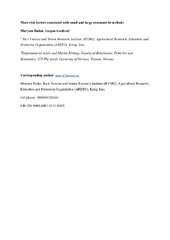Main risk factors associated with small and large ruminant brucellosis
Permanent lenke
https://hdl.handle.net/10037/24565Dato
2021-11-22Type
Journal articleTidsskriftartikkel
Peer reviewed
Sammendrag
Brucellosis is a neglected zoonotic bacterial disease in most of the developing world that has a significant impact on public health. The prevalence of brucellosis in livestock, particularly in large and small ruminants is variable in many countries and seems to remain high, especially amongst subsistence and small-scale livestock farmers. There are different factors that may influence the prevalence of brucellosis in large and small ruminants. This review is aiming at describing the most important factors that need to be taken into consideration for the planning and implementation of effective brucellosis control programmes. Common risk factors in the brucellosis development in small and large ruminant animals include species, age, sex, extensive or intensive production system, herd/flock size, mixed farming, introduction of new animals in the farms, breeding practice, hygiene, absence of vaccination, and awareness of the disease. This review suggests that different risk factors might have various impact on brucellosis seroprevalence that need to be addressed in epidemiological studies in different farming systems.
Beskrivelse
Forlag
Directorate of Knowledge Management in AgricultureSitering
Dadar M, Godfroid J. Main risk factors associated with small and large ruminant brucellosis. Indian Journal of Animal Sciences. 2021;91(11)Metadata
Vis full innførselSamlinger
Copyright 2021 The Author(s)


 English
English norsk
norsk